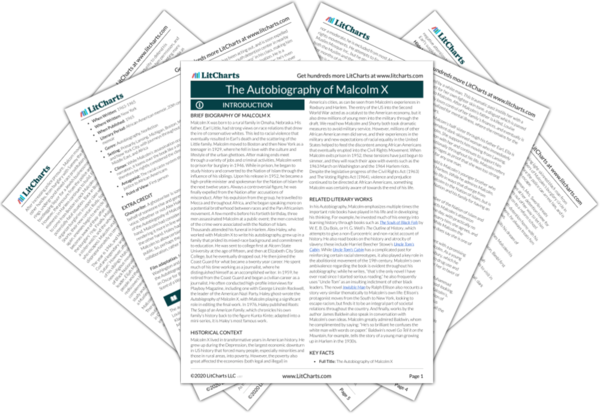Welcome to the LitCharts study guide on Malcolm X's The Autobiography of Malcolm X. Created by the original team behind SparkNotes, LitCharts are the world's best literature guides.
Malcolm X: Introduction
Malcolm X: Plot Summary
Malcolm X: Detailed Summary & Analysis
Malcolm X: Themes
Malcolm X: Quotes
Malcolm X: Characters
Malcolm X: Terms
Malcolm X: Symbols
Malcolm X: Theme Wheel
Brief Biography of Malcolm X

Historical Context of The Autobiography of Malcolm X
Other Books Related to The Autobiography of Malcolm X
- Full Title: The Autobiography of Malcolm X
- When Written: 1963-1965
- Where Written: New York
- When Published: 1965
- Literary Period: African-American memoir, 20th century memoir
- Genre: Autobiography, Nonfiction
- Setting: Primarily Lansing, Michigan, Boston, Massachusetts and New York City, with journeys throughout the US, the Middle East, and Africa
- Climax: While Malcolm’s assassination occurs outside of the narration, it looms over the book like a shadow, and can therefore be rightly considered the climax.
- Antagonist: The racial caste system that denies equality and justice to African Americans
- Point of View: First person
Extra Credit for The Autobiography of Malcolm X
Ghostwriter. A ghostwriter is someone who writes a book on behalf of someone else and generally attempts to mimic their voice. Whether or not Alex Haley is a ghostwriter in the context of the Autobiogrpahy of Malcolm X is up for debate. On the one hand, Malcolm had considerable oversight on the text, rendering it more in line with his own style and language. On the other hand, Haley had considerable influence in convincing Malcolm to allow certain thoughts and feelings to be made public. So, perhaps the Autobiography is best understood as a collaboration, rather than as the product of a ghostwriter.
Film adaptation. Malcolm X (1992), starring Denzel Washington and directed by Spike Lee, was largely based on the Autobiography of Malcolm X. Washington was nominated for an Oscar for Best Actor, but lost to Al Pacino’s performance in Scent of a Woman (1992) – a choice publicly criticized by Lee.












